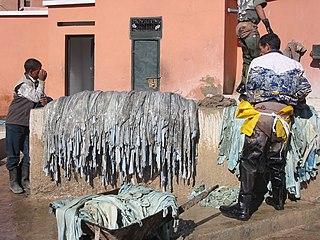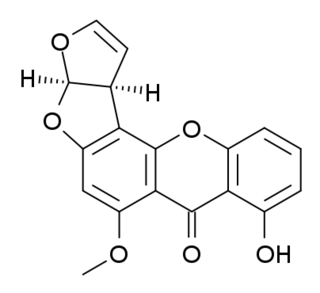
Leather is a natural durable and flexible material created by tanning animal rawhides and skins. The most common raw material is cattle hide. It can be produced at manufacturing scales ranging from artisan to modern industrial scale.

Phenol is an aromatic organic compound with the molecular formula C6H5OH. It is a white crystalline solid that is volatile. The molecule consists of a phenyl group (−C6H5) bonded to a hydroxy group (−OH). It is mildly acidic and requires careful handling due to its propensity for causing chemical burns.

Personal protective equipment (PPE) is protective clothing, helmets, goggles, or other garments or equipment designed to protect the wearer's body from injury or infection. The hazards addressed by protective equipment include physical, electrical, heat, chemicals, biohazards, and airborne particulate matter. Protective equipment may be worn for job-related occupational safety and health purposes, as well as for sports and other recreational activities. "Protective clothing" is applied to traditional categories of clothing, and "protective gear" applies to items such as pads, guards, shields, or masks, and others.

Tanning is the process of treating skins and hides of animals to produce leather. A tannery is the place where the skins are processed.

Cosmetics are substances or products used to enhance or alter the appearance of the face or fragrance and texture of the body. Many cosmetics are designed for use of applying to the face, hair, and body. They are generally mixtures of chemical compounds; some being derived from natural sources, and some being synthetics or artificial. Cosmetics applied to the face to enhance its appearance are often called make-up or makeup. Common make-up items include: lipstick, mascara, eye shadow, foundation, blush, and contour. Whereas other common cosmetics can include skin cleansers, body lotions, shampoo and conditioner, hairstyling products, perfume and cologne.

Toxicity is the degree to which a chemical substance or a particular mixture of substances can damage an organism. Toxicity can refer to the effect on a whole organism, such as an animal, bacterium, or plant, as well as the effect on a substructure of the organism, such as a cell (cytotoxicity) or an organ such as the liver (hepatotoxicity). By extension, the word may be metaphorically used to describe toxic effects on larger and more complex groups, such as the family unit or society at large. Sometimes the word is more or less synonymous with poisoning in everyday usage.

A blister is a small pocket of body fluid within the upper layers of the skin, typically caused by forceful rubbing (friction), burning, freezing, chemical exposure or infection. Most blisters are filled with a clear fluid, either serum or plasma. However, blisters can be filled with blood or with pus.
Cosmetology is the study and application of beauty treatment. Branches of specialty include hairstyling, skin care, cosmetics, manicures/pedicures, non permanent hair removal such as waxing and sugaring and permanent hair removal processes such as electrology and intense pulsed light (IPL).

A blister agent, or vesicant, is a chemical compound that causes severe skin, eye and mucosal pain and irritation. They are named for their ability to cause severe chemical burns, resulting in painful water blisters on the bodies of those affected. Although the term is often used in connection with large-scale burns caused by chemical spills or chemical warfare agents, some naturally occurring substances such as cantharidin are also blister-producing agents (vesicants). Furanocoumarin, another naturally occurring substance, causes vesicant-like effects indirectly, for example, by increasing skin photosensitivity greatly. Vesicants have medical uses including wart removal but can be fatal if even small amounts are ingested.

A chemical burn occurs when living tissue is exposed to a corrosive substance such as a strong acid or base. Chemical burns follow standard burn classification and may cause extensive tissue damage. The main types of irritant and/or corrosive products are: acids, bases, oxidizers / reducing agents, solvents, and alkylants. Additionally, chemical burns can be caused by some types of chemical weapons, e.g., vesicants such as mustard gas and Lewisite, or urticants such as phosgene oxime.

Clobetasol propionate is a corticosteroid of the glucocorticoid class used to treat various skin disorders including eczema and psoriasis. It is also highly effective for contact dermatitis caused by exposure to poison ivy/oak. Clobetasol belongs to US Class I of the corticosteroids, making it one of the most potent available. It comes in shampoo, mousse, ointment and emollient cream presentations. It has very high potency and typically should not be used with occlusive dressings, or for extended continuous use. It is also used to treat several autoimmune diseases including alopecia areata, lichen sclerosus, and lichen planus.

A patch test is a method used to determine whether a specific substance causes allergic inflammation of a patient's skin. Any individual suspected of having allergic contact dermatitis or atopic dermatitis needs patch testing.
A chemical depilatory is a cosmetic preparation used to remove hair from the skin. Common active ingredients are salts of thioglycolic acid and thiolactic acids. These compounds break the disulfide bonds in keratin and also hydrolyze the hair so that it is easily removed. Formerly, sulfides such as strontium sulfide were used, but due to their unpleasant odor, they have been replaced by thiols.

Exfoliation involves the removal of the oldest dead skin cells on the skin's outermost surface. Exfoliation is involved in all facials, during microdermabrasion or chemical peels. Exfoliation can be achieved by mechanical or chemical means.
α-Hydroxy acids, or alpha hydroxy acids (AHAs), are a class of chemical compounds that consist of a carboxylic acid substituted with a hydroxyl group on the adjacent carbon. They may be naturally occurring or synthetic. AHAs are well known for their use in the cosmetics industry. They are often found in products that aid in the reduction of wrinkles, that soften strong, defining lines, and that improve the overall look and feel of the skin. They are also used as chemical peels. AHAs have effective results through continuous treatment in the cosmeceutical industry.
A chemical peel is a technique used to improve and smooth the texture of the skin. Facial skin is mostly treated, and scarring can be improved. Chemical peels are intended to remove the outermost layers of the skin. To accomplish this task, the chosen peel solution induces a controlled injury to the skin. Resulting wound healing processes begin to regenerate new tissues. The dead skin eventually peels off. The regenerated skin is usually smoother and less wrinkled than the old skin. Some types of chemical peels can be purchased and administered without a medical license, however people are advised to seek professional help from a dermatologist or plastic surgeon on a specific type of chemical peel before a procedure is performed.
Hazard statements form part of the Globally Harmonized System of Classification and Labelling of Chemicals (GHS). They are intended to form a set of standardized phrases about the hazards of chemical substances and mixtures that can be translated into different languages. As such, they serve the same purpose as the well-known R-phrases, which they are intended to replace.
Shock is a fictional character, and a supervillain in the Marvel Comics universe. A psychopathic killer, she fought with Daredevil in New York City. Shock possesses the power to induce fear and hallucinations in other people by releasing pheromones through her skin.

Pregnenolone acetate, also known as pregn-5-en-3β-ol-20-one 3β-acetate, is a synthetic pregnane steroid and an ester of pregnenolone which is described as a glucocorticoid and as a skin-conditioning and skin anti-aging agent. It has been found to significantly reduce wrinkles in elderly women when applied in the form of a 0.5% topical cream, effects which were suggested to be due to improved hydration of the skin. Pregnenolone acetate has been marketed in France in a topical cream containing 1% pregnenolone acetate and 10% "sex hormone" for the treatment of premature skin aging but was withdrawn from the market in 1992. Although the medication has been described by some sources as a glucocorticoid, other authors have stated that systemic pregnenolone acetate has no undesirable metabolic or toxic effects even at high dosages.


















